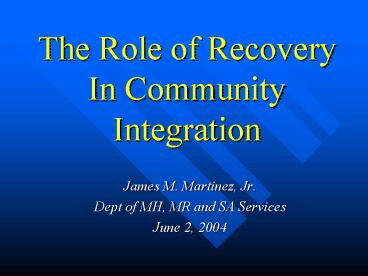The Role of Recovery In Community Integration - PowerPoint PPT Presentation
1 / 30
Title:
The Role of Recovery In Community Integration
Description:
Dept of MH, MR and SA Services. June 2, 2004. What is Recovery? ... CELT, LEAP Leadership Training. VHST Virginia Human Service Training ... – PowerPoint PPT presentation
Number of Views:67
Avg rating:3.0/5.0
Title: The Role of Recovery In Community Integration
1
The Role of Recovery In Community Integration
- James M. Martinez, Jr.
- Dept of MH, MR and SA Services
- June 2, 2004
2
What is Recovery?
3
Recovery is a way of living a satisfying,
hopeful, and contributing life even with
limitations caused by illness. -
W. Anthony, Ph.D. (1993)
4
Recovery is getting my life back.
MHPC Member, May 14, 2004
5
Why the focus on Recovery?
6
Recovery Concepts in Mental Health
- Vermont Longitudinal Study (C. Harding, et. al.,
1987) - 269 Former Inpatients
- Avg. follow-up 32 years post discharge
- Rates of significant improvement or recovery
62-68
7
Why Was This Study Important?
8
Vermont Longitudinal Study (cont.)
- Recovery defined as
- Having a social life similar to others in the
wider community - Holding a paying job or volunteering
- Being symptom free
- Being off of psychiatric medications
- 62 of people diagnosed with schizophrenia met 3
of the 4 criteria
9
Getting my life back
10
Getting my life back How?
11
Recovery is as individual as the individual
-Yvette Sangster (in
NTAC newsletter, 1999)
12
Recovery is less about returning to ones former
self than about discovering who one can become.
13
Some Consumer Views (W.P. Sullivan, 1994)
- 46 current and former MH service recipients
- 74 schizophrenia, 17 bipolar disorder
- Avg. age 39 years old
- 5.6 previous hospitalizations (avg.)
- 6.3 years (avg.) since last hospitalization
- 8.7 years between first/last admission
14
Factors for Success(W.P. Sullivan, 1994)
- Medication - 74
- Comm. Support/Case Mgmt. 67
- Self-Will Self-Monitoring 63
- Vocational Activity (incl. School) 46
- Spirituality 43
- Knowledge Acceptance Illness 35
- Mutual Aid Supportive Friends 33
- Significant Others 30
15
People with mental illness recover. What should
providers do?
16
Disease Centered Model
- Professional Role
- Hierarchical
- Paternal
- In-charge
- Holds the important knowledge
- Responsible for treatment
- Disease is focus
- Patient Role
- Subservient
- Obedient
- Passive
- Recipient of knowledge
- Responsible for following treatment
- Host of disease
17
Recovery is a Person-Centered Model
- Persons Role
- Personal power
- Personal knowledge
- Personal responsibility
- Person in context of life is focus
- Person is self-determining
- Professional Role
- Power sharing
- Exchange information
- Shared decision-making
- Co-investigator
- Professional is expert consultant on journey
18
Some Current Opportunities to Foster Recovery
- Mental Health Planning Council Priority
- DMHMRSAS Commitment
- Restructuring Vision
- Regional Restructuring Partnerships
- Presidents New Freedom Commission
- Olmstead Task Force Recommendations
- CMHS Recovery Grant
19
Some Current Initiatives
- Restructuring Emphasis
- Regional/local CSB initiatives (e.g. HPR II)
- VOCAL Consumer-Run Programs
- CELT, LEAP Leadership Training
- VHST Virginia Human Service Training
- CMHS/AHP Recovery Grant to DMHMRSAS (just
starting) - REACH Recovery Education and Creative Healing
(just starting)
20
A New Initiative REACH
- Goal Transformation to a Recovery-Based Mental
Health Service System - Administered through VOCAL
- Wellness Recovery Action Plan (WRAP)
21
WRAP Some Key Components
- Hope
- Self-Determination
- Personal Responsibility
- Education
- Self-Advocacy
- Support
- Getting Good Health Care
- Medication Management
22
WRAP - Contents
- Wellness Toolkit
- Daily Maintenance Plan
- Triggers (external)
- Early Warning Signs (internal)
- When Things Are Breaking Down
- Crisis Plan
- Post-Crisis Plan
23
Additional Recovery Topics
- Building self-esteem
- Changing negative thoughts to positive
- Peer support
- Work related issues
- Trauma recovery
- Suicide prevention
- Others
24
WRAP Values Ethics
- Inclusive
- Self-determination
- Validates lived experience
- No limits to recovery
- Dignity, compassion, respect
- Focus on strengths
- Egalitarian
- Honors all stakeholders
- Unconditional acceptance of personal process
- Projects hope
- No predetermined outcomes
- Work at own pace
25
Two-Tiered Approach
- Grassroots Level
- WRAP groups in local communities
- Identify graduates to become facilitators
- Training grants from VOCAL, MHPC, etc.
- Establish more WRAP groups
- Train more facilitators
- Wellness recovery spread
26
Two-Tiered Approach (cont.)
- Statewide Level VOCAL/REACH
- Consumer Advisory Group
- Kick-off event with stakeholders (consumers,
CSBs, facilities, advocacy/support groups) - WRAP training 2 people from each HPR
- WRAP groups started in each HPR
- Wellness and recovery spreads
27
Always REACHing HigherREACH Contact Mary
McQuownmary.mjm_at_cox.net
28
The fallacies of total insanity, hopelessness
and incurability should be attacked and the
prospects of recovery and improvement through
modern concepts of treatment and rehabilitation
emphasized- from a 1961 report of the AMA,
APA, AAN and DOJ, quoted by C.M Harding, in New
York Times, March 10, 2002
29
our system will not be restructured
appropriately until we fully understand, fully
embrace, and fully implement the concepts of self
determination, empowerment and recoveryCommissi
oner J.S.Reinhard, M.D.in The Partnership Press,
May 2004
30
Thank you all































